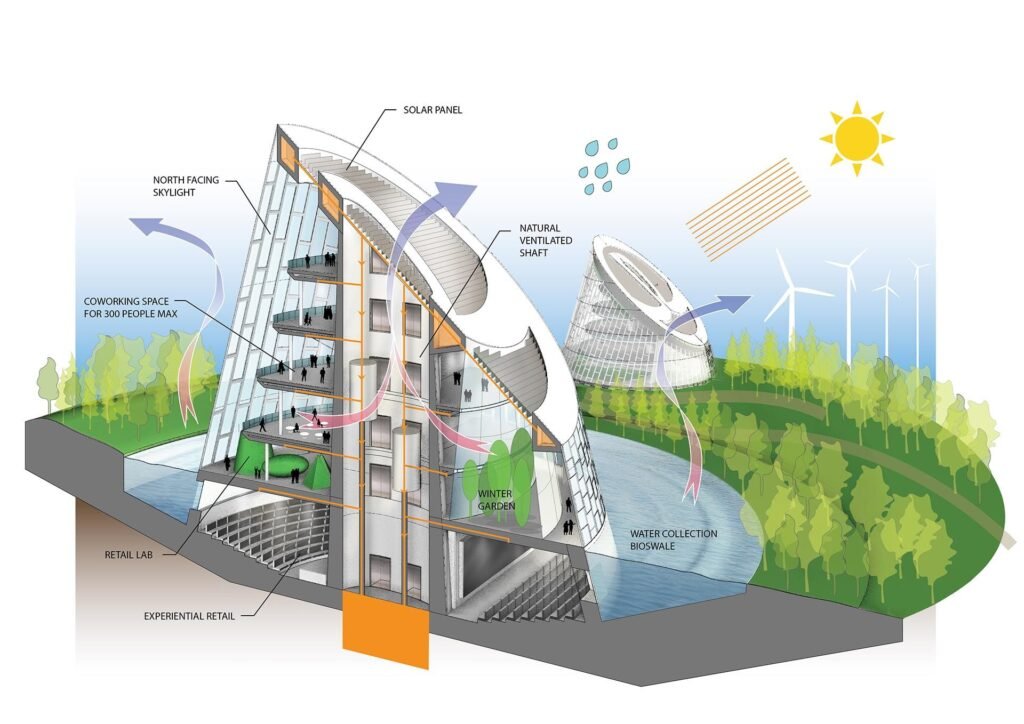
Climate change is one of the most pressing issues of our time, and the construction industry plays a significant role in its mitigation. A well-planned construction of an infrastructure, where sustainability has been given its due space, and where the use of renewable sources of energy is the priority, must be inculcated to build a better future.
Following the same, Green buildings have emerged as a sustainable solution to reduce environmental impact, conserve energy, and enhance overall sustainability.
What Are Green Buildings?
Green buildings are structures designed and constructed to minimize their environmental footprint. They incorporate sustainable practices, energy-efficient systems, and eco-friendly materials to reduce resource consumption and carbon emissions.

How is it Combating Climate Change?
1. Reduction in Carbon Emissions
Traditional buildings contribute significantly to greenhouse gas emissions due to high energy consumption. Green buildings, on the other hand, use renewable energy sources like solar and wind power, reducing dependency on fossil fuels and lowering carbon emissions.
2. Energy Efficiency
Energy-efficient designs, such as improved insulation, natural lighting, and smart energy systems, ensure lower energy consumption.
3. Water Conservation
Green buildings incorporate water-efficient fixtures, rainwater harvesting, and wastewater recycling systems to minimize water wastage.
4. Use of Sustainable Materials
Eco-friendly materials such as recycled steel, bamboo, reclaimed wood, and low-impact concrete help in reducing the carbon footprint of construction activities.
5. Waste Reduction and Management
Green buildings emphasize efficient waste management strategies, including recycling construction waste, composting organic waste, and minimizing landfill contributions.
6. Improved Air Quality
By using non-toxic paints, natural ventilation systems, and advanced air purification technologies, green buildings improve indoor air quality. This leads to healthier living and working environments, reducing health risks associated with pollution.
7. Enhancing Biodiversity
Green roofs, vertical gardens, and landscaping with native plants contribute to urban biodiversity. These elements provide habitats for wildlife, promoting ecological balance.

The Economic and Social Benefits of Green Buildings
Apart from environmental advantages, green buildings offer economic and social benefits:
- Lower Operational Costs: Energy and water savings lead to reduced utility bills.
- Higher Property Value: Green-certified buildings tend to have higher resale values and attract premium tenants.
- Increased Productivity: Healthier indoor environments improve resident well-being and productivity.
- Job Creation: The green construction sector generates employment opportunities in renewable energy, waste management, and sustainable architecture.
Know the Challenges:
Despite their benefits, green buildings face challenges such as:
- Higher Initial Costs: Sustainable materials and technologies can have higher upfront expenses.
- Lack of Awareness: Many developers and consumers are still unaware of the advantages of green buildings.
- Regulatory Hurdles: Some regions lack supportive policies and incentives for green construction.
What’s for the future?
With the growing emphasis on sustainability, green buildings are set to become the standard in the construction industry. Government initiatives, technological advancements, and increased awareness are driving the adoption of sustainable building practices worldwide.
Conclusion
Green building practices, which prioritize environmentally friendly materials, energy efficiency, and resource conservation, have emerged as one of the most effective responses to mitigate the negative impact of conventional construction on the environment.
Green buildings play a crucial role in addressing climate change by reducing carbon emissions, improving energy efficiency, and promoting sustainable resource use. Investing in green buildings is not just an environmental necessity but also an economic and social opportunity.
By adopting green construction practices, we can move towards a more sustainable future and combat climate change effectively. Many modern builders like Vinra Group are consistently putting an effort to normalise this modern concept of green buildings, by providing the right guidance, and services, as well as improving the technique to make it more cost-efficient and accessible to everyone. It’s not the business but their inner voice to bring a positive change in the society.
With urbanization on the rise, the importance of green building has never been more apparent. Let’s make the world a better place.